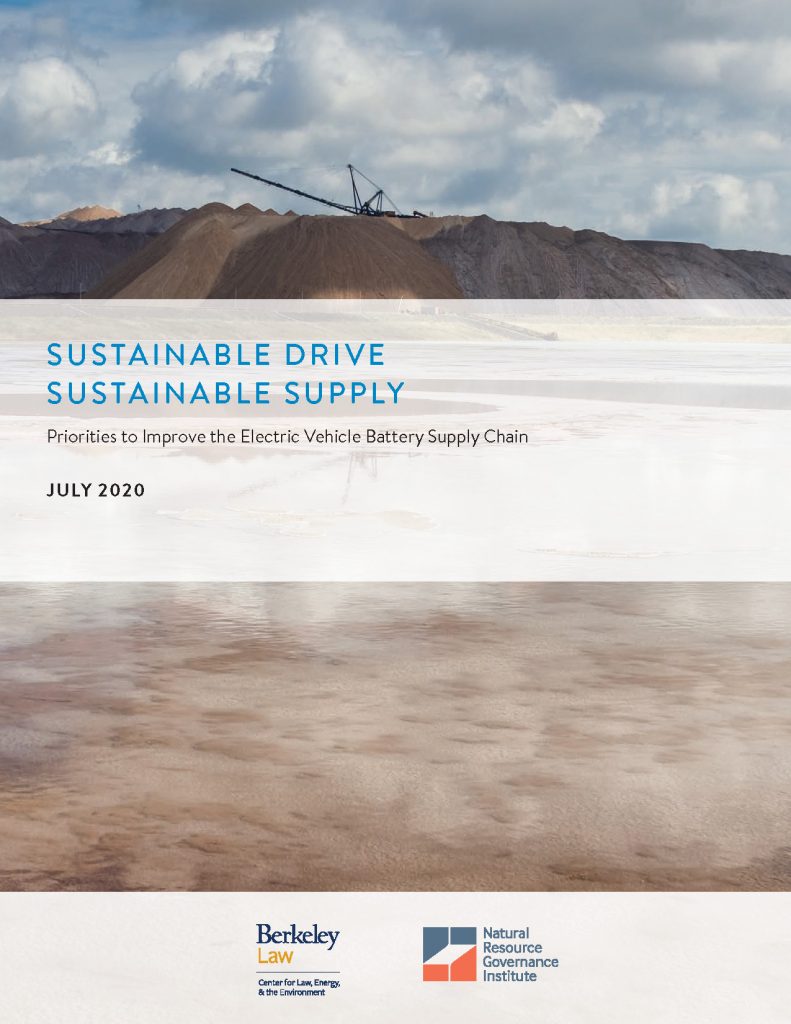
CLEE and the Natural Resource Governance Institute (NRGI) are pleased to release today the new report “Sustainable Drive, Sustainable Supply: Priorities to Improve the Electric Vehicle Battery Supply Chain.” The report identifies key challenges and solutions to ensure battery supply chain sustainability through a multi-stakeholder approach, based on our outreach to experts in the field.
The global transition from fossil fuel-powered vehicles to battery electric vehicles (EVs) will require the production of hundreds of millions of batteries. This massive deployment frequently raises questions from the general public and critics alike about the sustainability of the battery supply chain, from mining impacts to vehicle carbon emissions.
To address these questions, CLEE and NRGI are conducting a stakeholder-led research initiative focused on identifying strategies to improve sustainability and governance across the EV battery supply chain. CLEE and NRGI convened leaders from across the mining, battery manufacturing, automaker, and governance observer/advocate sectors, to develop policy and industry responses to human rights, governance, environmental, and other risks facing the supply chain.
“Sustainable Drive, Sustainable Supply” identifies the following key challenges to ensuring battery supply chain sustainability:
- Lack of coordinated action, accountability, and access to information across the supply chain hinder sustainability efforts
- Inadequate coordination and data sharing across multiple supply chain standards limit adherence
- Regulatory and logistical barriers inhibit battery life extension, reuse, and recycling
The report recommends the following priority responses that industry, government and nonprofit leaders could take to address these challenges:
- Industry leaders could strengthen mechanisms to improve data transparency and promote neutral and reliable information-sharing to level the playing field between actors across the supply chain and between governments and companies
- Industry leaders and third-party observers could ensure greater application of supply chain sustainability best practices by defining and categorizing existing standards and initiatives to develop essential criteria, facilitate comparison and equivalency, and streamline adherence for each segment of the supply chain
- Governments and industry leaders could create new incentives for supply chain actors to participate in and adhere to existing standards and initiatives, which may include sustainability labeling and certification initiatives
- Industry leaders could design batteries proactively for disassembly (enabling recycling and reuse), and industry leaders and governments could collaborate to build regional infrastructure for battery recycling and transportation and create regulatory certainty for recycling
We hope the responses to the supply chain challenges outlined in this report will provide guidance on the initial actions stakeholders can take to make this broader vision of implementation a reality, ensuring a more robust future for communities around the globe as well as for all-important electric vehicle adoption to meet climate change goals.
To learn more about this issue and the new report, join our 9am PT / Noon ET webinar today, featuring:
- Patrick Heller, Senior Visiting Fellow, Center for Law, Energy & the Environment (CLEE) & Advisor, Natural Resource Governance Institute (NRGI)
- Michael Maten, Automotive Public Policy, Electrification, Portfolio Planning and Strategy, General Motors
- Daniel Mulé, Senior Policy Advisor for Tax and Extractive Industries, Oxfam
- Payal Sampat, Mining Program Director, Earthworks
You can register for the webinar; read our recent FAQ on EV batteries for more information on current supply chain impacts on human rights, climate change and the local environments; and download the new report “Sustainable Drive, Sustainable Supply: Priorities to Improve the Electric Vehicle Battery Supply Chain.”
Note: this post is co-authored with Ted Lamm.
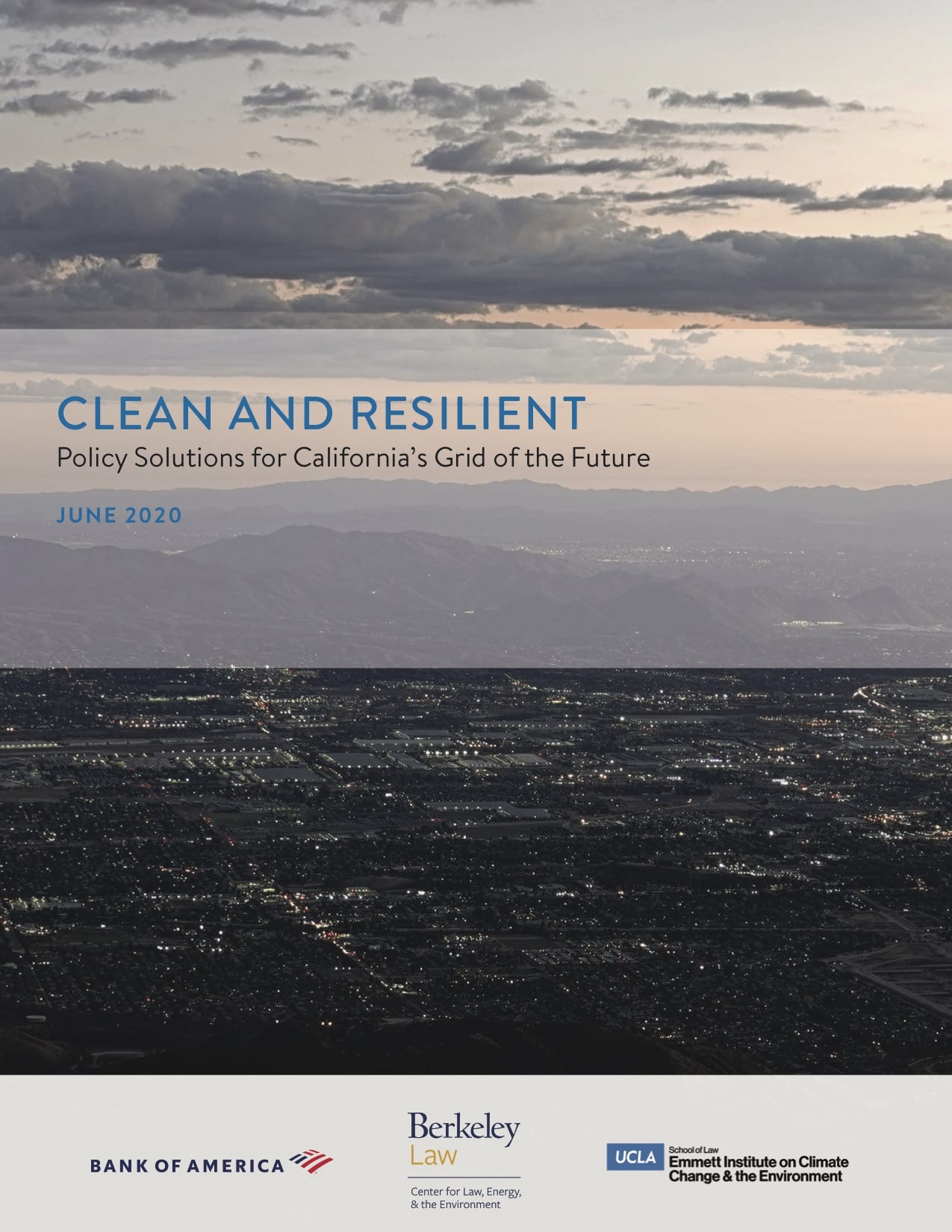
California’s electrical grid is at the center of our fight against climate change, with aggressive goals to decarbonize through renewable energy. But the grid is at risk as climate impacts become more severe, particularly from worsening wildfires. To help modernize the grid to be cleaner and more resilient, the state will need deployment of clean technologies such as distributed renewable generation, microgrids, energy storage, building energy management, and vehicle-grid integration.
Part of the vulnerability of the grid stems from its role in exacerbating climate impacts. Most prominently, power lines sparked many of the record-setting wildfires of 2017 and 2018, including the Camp Fire that destroyed the town of Paradise. To minimize this threat during high-risk weather conditions, California electric utilities and energy regulators have begun to implement preemptive power shutoffs. In 2019, widespread PSPS events likely contributed to a safer wildfire season, but the days-long shutoffs also left some vulnerable communities and residents without access to essential health and safety services.
At the same time, many residents turn to fossil-fuel backup generators during grid shutoffs, which both polluting (in terms of both greenhouse gases and locally harmful air pollutants) and unaffordable for many Californians. But the alternative—deploying clean, resilient distributed resources, such as home batteries, community solar, or microgrids—will require significant policy and financial support for grid managers, electric utilities, community choice aggregators, and local governments.
To address this need, CLEE and UCLA’s Emmett Institute convened a group of California state energy regulators, local government leaders, grid experts, and clean energy advocates for a convening on California’s electrical grid of the future. CLEE and Emmett are today releasing a new report, Clean and Resilient, based on this expert group’s findings.
The report highlights the top policy solutions the group identified to address the financial, regulatory, and data barriers to clean, resilient grid deployment, including:
- Promoting performance-based regulation at the California Public Utilities Commission, to ensure that the public benefits and necessity of investments in reliable, carbon-free technology are fully accounted for.
- Reforming grid interconnection processes (including CPUC Rules 2 and 21) to create a presumption in favor of new microgrids and other distributed technologies and to equitably share the cost of associated grid upgrades.
- Initiating a new energy data collection and management process at the California Energy Commission to ensure communities, technology providers, and regulators have access to the data that will drive the grid of the future.
You can access the report and its full set of policy recommendations here. Ultimately, developing the clean and resilient electrical grid California needs will rely on a suite of parallel initiatives, from building and vehicle electrification to advanced data and communications development, each of which will require additional support. Given the range of these interconnected efforts, and the urgency of our statewide need for a safe, reliable grid, developing coordinated policy processes to promote them is becoming increasingly essential.
Some media appearances from me this week on a range of energy, housing and rail topics:
- “Greater LA” on KCRW radio in Los Angeles covered the conspiracy theory that auto companies dismantled the vast Los Angeles streetcar network in favor of freeways, interviewing me for the segment based on my Railtown book.
- CalMatters reported on a new state legislative analysis of California’s renewable energy program, finding significant emission reductions and many research gaps, which helps deflate a Republican proposal to pause the program (with some quotes from me).
- KPCC’s AirTalk radio program featured a live discussion on Wednesday on the proposed “California Green New Deal” legislation, which in part seeks to boost affordable housing and a just transition for workers out of fossil fuels. I was joined on the program by Sylvia Chi from the Asian Pacific Environmental Network and Christopher Thornberg, founding partner of Beacon Economics.
With the legislative session just beginning, I expect the media to continue to focus on the numerous proposals to address our ongoing energy and climate needs. Happy Friday!

I began working on climate change law and policy on January 20, 2009, the day I joined Berkeley Law, which was coincidentally Barack Obama’s Inauguration Day. So it’s been a full decade for me focusing exclusively on this subject (I focused on related land use and transit issues prior to 2009), roughly coinciding with the 2010s now coming to a close.
As we mark the end of this decade, two things stand out: remarkable progress reducing the price and deploying critical clean technologies, and dispiriting failure to reduce overall greenhouse gas emissions, with more severe climate impacts happening each year.
I noted some of these trends in a foreword to “Climate Change Law in the Asia Pacific” from Berkeley Law, which features articles from scholars in places like Japan, Korea, and Taiwan, as well as California.
To summarize the good news on clean technology:
- From 2009 to 2017, the levelized costs for utility-scale solar photovoltaic dropped 86 percent;
- Wind power levelized costs dropped 67 percent from 2009-2017; and
- Lithium ion battery prices (central to electric vehicles and grid energy storage) have dropped 85 percent from 2010 to 2018.
This progress is the key reason for optimism on climate change. With the price decreases, support for deployment has increased across the political spectrum and allowed for some remarkable success stories on emissions reductions, such as California’s ability to achieve its 2020 carbon goals four years earlier, due primarily to renewable energy deployment.
But despite the progress, we have this sobering data:
- Carbon parts per million have increased from 385 in 2009 to 411 (and counting).
And unsurprisingly, the bill is now coming due. This decade has brought some of the predicted severe climate impacts, such as unprecedented wildfires, droughts, extreme rain events and hurricanes, and warming oceans.
On the positive side, the extreme weather has helped shift public opinion in favor of climate action. But it’s come at a significant cost to human life, happiness, and ecosystems.
Hopefully in the 2020s we’ll see the widespread deployment of clean technologies and other climate-smart practices that we need to stabilize and reduce emissions. And while climate impacts will inevitably worsen, perhaps our ability to withstand them will improve, such as through electricity grid resilience in the face of wildfires and using natural infrastructure to lessen storm surges and flooding.
And to make any of these positives happen, we will need smart policies and public support and political leaders to enact them. I’ve had the good fortune to work on climate policy now for over a decade, and as the 2020s dawn, much work remains.
The dark winter months are a reminder that critical renewable resources like solar PV won’t be available to keep our electricity clean. And if the wind isn’t blowing, wind power is unavailable as well to meet demand. Absent baseload renewables like geothermal power, how do we achieve a 100% carbon-free in the dark, still winter time?
The answer is bulk — or seasonal — energy storage. This means massive energy storage facilities that can capture surplus renewable power like solar PV in the summer months, and store it for months until the winter.
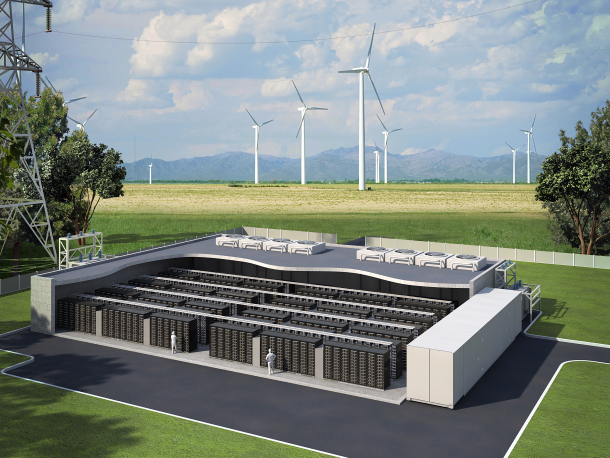
Not many technologies can achieve this mass, seasonal storage, but Utility Dive offers a helpful list, summarized here:
- Pumped Hydro: this relatively common technology involves pumping water uphill with cheap surplus electricity and then releasing it downhill to generate power when needed. It’s been in use since the 1890s, and by the end of 2017, the US had about 22 gigawatts installed.
- Compressed Air Energy Storage: this technology involves pumping air into a confined space, like a container or underground cavern, then releasing the pressure to generate electricity when needed. It’s a capital-intensive system constrained by geography. To date, I only know of two facilities in operation, although more are in the planning stages.
- Lithium-ion battery banks: with falling battery prices, these have been a “go-to” recently for energy storage. But it’s unclear if we can produce and deploy enough batteries to store power for months at grid-scale, particularly since many of these batteries will be needed for electric vehicles.
- Other batteries: By the end of 2017, the U.S. had 708 megawatts of large-scale battery capacity other than lithium, according to the U.S. Energy Information Administration.
- Gravity-based systems: more developers are experimenting with gravity-based systems, such as trains that power uphill and then go back downhill to release energy when needed, as I blogged about a few years ago. As another example, Switzerland-based Energy Vault unveiled a crane mounted on a steel tower 300 feet high, which hoists 35 metric ton concrete “bricks” into stacks. To discharge, the crane lowers the bricks to the ground.
- Hydrogen: liquid hydrogen gas can be a form of energy storage, if it’s produced with surplus renewable power. It can be stored without degrading and used to power a fuel cell or gas turbine (or to power fuel cell vehicles like hydrogen trucks).
Other technologies may exist or be in the planning stages to overcome this seasonal challenge with providing 100% carbon-free power all year. As more jurisdictions seek to meet this clean power goal, these bulk storage technologies will become critical in the near future.

PG&E’s decision to cut power last month (and possibly again this week) to hundreds of thousands of customers has thrown Northern California into disarray. Yet despite the blackouts, fires still raged, with people evacuating and in some cases losing homes.
How did California end up in this situation? Who was most affected by the power shut-offs, and what can be done to keep the lights on in the future?
We’ll discuss on City Visions tonight at 7pm, with guests:
- Nick Chaset, Chief Executive Officer of East Bay Community Energy;
- Martha Guzman Aceves, Commissioner at the California Public Utilities Commission; and
- Michael Wara, Director of the Climate and Energy Policy Program at the Stanford Woods Institute for the Environment.
Tune in at 7pm at 91.7 FM in the San Francisco Bay Area or stream live. Call 866-798-TALK (8255) with questions or email us at cityvisions@kalw.org!
Good news on California’s efforts to fight climate change: in-state emissions in 2017 (the latest available data) were down over 2016 and ahead of the state’s mandatory 2020 goals. The California Air Resources Board announced the progress yesterday, with this chart showing emissions in context of population and GDP:

Overall, emissions totaled 424 million metric tons of carbon dioxide equivalent in 2017, down 5 million metric tons from 2016. For reference, the 2020 reduction target is 431 million metric tons.
Most of the progress came from the electricity sector, where for the first time renewable sources made up a larger percentage of the generation than fossil fuels.
However, transportation emissions increased 0.7% in 2017, compared to a 2% increase in 2016, mostly from passenger vehicles. That total is even worse when you consider pollution from oil and gas refineries that make the fuel for these passenger vehicles. Together with hydrogen production, these sources constituted one-third of the state’s total industrial pollution.
Here’s the latest pie chart on where the emissions came from in 2017:
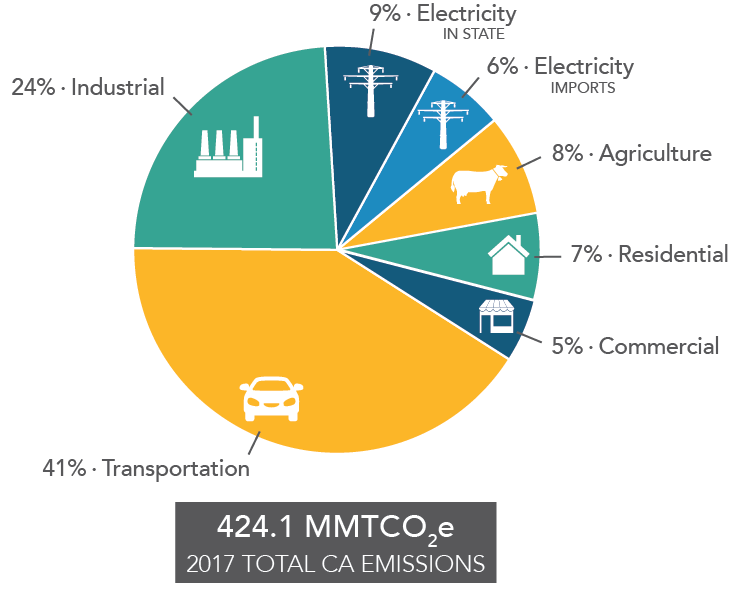
While the story is overall positive for California’s climate efforts, the state will have to redouble its efforts to reduce driving miles by allowing more homes to be built near jobs and transit, while transitioning the remaining driving miles to zero-emission technologies like electric vehicles.
Los Angeles mayor Eric Garcetti made headlines recently by unveiling the city’s version of a “Green New Deal,” complete with ambitious goals to create a zero-emission transportation network, a zero-carbon electricity grid, and a Los Angeles that “won’t send a single piece of trash” to the landfill by 2050.
The goals in the new sustainability plan [PDF] are necessary to meet our environmental and sustainability needs, but how can the city make them feasible to achieve?

I discussed the zero-waste goal in particular on KPCC radio’s AirTalk program, along with my UCLA Law colleague Cara Horowitz. My comments were drawn largely from the 2016 CLEE report “Wasting Opportunities” on boosting energy recovery from municipal solid waste to meet climate goals.
The bottom line? Achieving zero waste will require significant reduction of materials in use, increases in recycling and composting, and — yes — some type of energy recovery from whatever is left over. You can listen to the broadcast here.
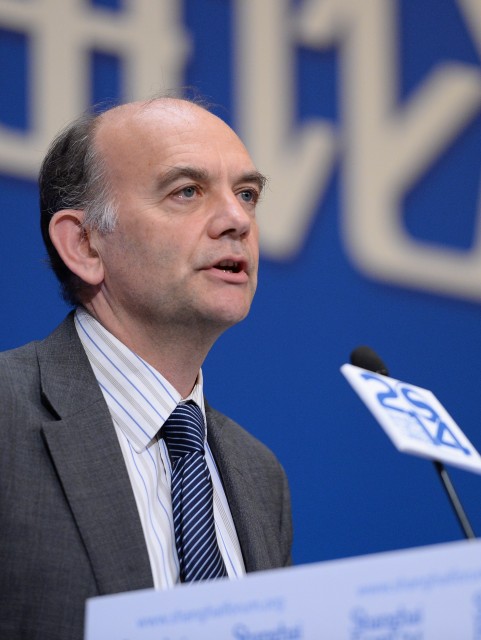
For those in the Bay Area, Berkeley Law’s Center for Law, Energy and the Environment (CLEE) will be hosting a free brown bag lunch talk today with Prof. Michael Grubb, professor of Energy and Climate Change at the University College of London.
Professor Grubb has been at the forefront of the United Kingdom’s successful-to-date effort to reduce carbon emissions from its electricity sector. In a talk entitled “Innovation, economics and policy in the energy revolution: Insights from the UK electricity transition and wider implications,” Dr. Grubb will describe how this transition occurred.
The event will run from 12:50 to 2pm in Boalt Room 10. More info and RSVP here. Hope to see you there!
I’ll be a guest on KPCC radio’s AirTalk program today at 10:20am, discussing the decision by the Los Angeles Department of Water and Power, at the urging of Mayor Garcetti, to phase out natural gas plants along the coast rather than rebuild them.
The plants will be replaced by renewable energy sources and energy storage, among other clean resources. Some business groups are concerned about the economic impacts on ratepayers, including the other guest, Stuart Waldman, president of the Valley Industry and Commerce Association.
It should be a lively discussion, so I hope you can tune in and ask questions!


